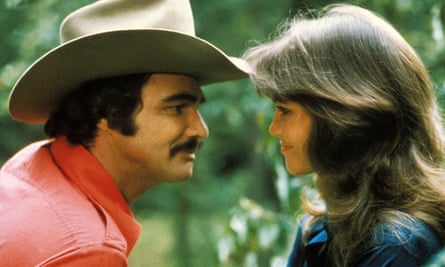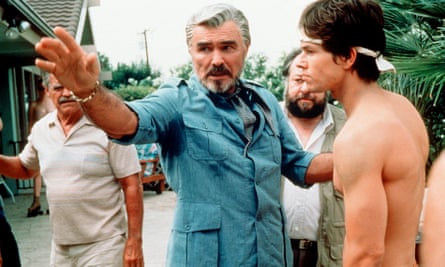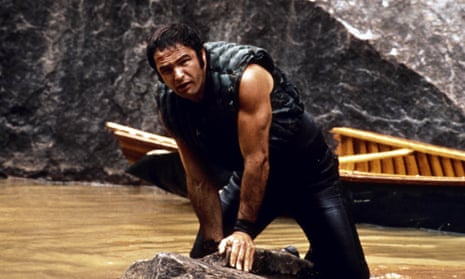At his peak, Burt Reynolds had the kind of face, the kind of body, the kind of masculinity and appeared in the kind of movie that hasn’t been fashionable in Hollywood for decades. From 1978 to 1982, Burt Reynolds in all his easygoing ruggedness was the undisputed king: the industry’s top grossing star every year in that time for increasingly unfashionable but lucrative pictures. It was a short but legendary reign, after which his awful career moves, calamitous personal investments and matrimonial woes put his star into the descendant. But, like Travolta, he enjoyed a hip and postmodern comeback in the 1990s as the porn movie mogul in Paul Thomas Anderson’s Boogie Nights (1997), a role with a streak of darkness which reconnected to him to the disturbing John Boorman picture that made his name in 1972, Deliverance, the story of four white salarymen who go on a trip to the Georgia wilderness, unwisely patronise the locals and encounter a situation which unlocks ruthless violence in Reynolds’s character.
But Deliverance – however sensational it was – was a slightly atypical role for Reynolds. In his glorious, sunlit heyday, Burt Reynolds was an easygoing figure. He had a wide, handsome and very intelligent face: sometimes accessorised with a big moustache, he appeared in an outdoors-guy leather, denim, sometimes in lawman’s uniform or sports kit — the kind of rangy look that was later co-opted by the gay community. Reynolds had a fine singing voice and appeared opposite Dolly Parton in the musical The Best Little Whorehouse In Texas, and in 1973 released a country album called Ask Me What I Am.
This video has been removed. This could be because it launched early, our rights have expired, there was a legal issue, or for another reason.
What indeed? Burt Reynolds wasn’t exactly an action star, nor a comic, nor a romantic lead, but he could play all of those, and had a strong line in gallantry. Reynolds basically played a character usually relegated to second billing: the good ol’ boy, who loved beers, girls, sports and especially cars – often racing them against the cops, in that utterly vanished kind of action comedy where dozens of squad cars are in pursuit of one lovably roguish scamp. And Reynolds could as well play the police officer as the roguish outlaw. In some ways, Burt Reynolds was a cross between Steve McQueen and the Elvis Presley who appeared in dozens of his own indistinguishable movie vehicles. While the 1970s were promoting newer, more cerebral, less macho stars like Woody Allen and Dustin Hoffman, Reynolds was a holdout, an unapologetic man’s man.

In movies like Smokey and the Bandit, and The Cannonball Run (with their various sequels) or WW and the Dixie Dance Kings, Reynolds popularised like no other actor that twinkly-eyed male star, with a touch of the rebel. And as he himself was a former college football player, he was a very convincing star of football movies like The Longest Yard and Semi-Tough. Reynolds loved to work with the people that he trusted, again and again, in the kind of material that he felt comfortable with, and he directed a handful of features in which he starred. But his career was not well managed. There were rumours that he had turned down everything from Star Wars to Pretty Woman; finally, he wasn’t even being considered for the interesting roles, and arguably did not find a way to develop as a character actor. However unfairly, some in the industry felt that there was something one-note in Reynolds’s acting style which wasn’t ageing well.
Perhaps no serious role could possibly match up to the extraordinary impact of Deliverance. The male rape scene, in which the victim is told to “squeal like a pig”, and the assailant is brutally killed, has the power to shock. If it had come out in a later era, it might have coloured Reynolds’s career much more than it did: that grisly scene would be endlessly replayed on YouTube and discussed online. In the same year, Reynolds courted controversy by doing a near-nude centrefold, a move he regretted. But in that era, there were more career chances for actors – male actors that is.

Reynolds was reborn in Boogie Nights in 1997 as a faintly bizarre, but weirdly charming silver-fox porn producer who has to sweet-talk Mark Wahlberg’s handsome kid into appearing in one of his dirty movies, and he has big dreams of creating a kind of pornography with a real narrative. There is a touch of tongue-in-cheek in the casting here: Reynolds, the hilariously dated 70s and 80s icon, re-emerges as a louche smoothie. But Reynolds plays it with great sangfroid, and it earned him an Oscar nomination and a Golden Globe win. British audiences fondly came to notice Burt Reynolds in Dolland and Aitchison ads on TV, and he managed his later years with good humour and self-deprecation. He is an icon of Hollywood of the Carter/Reagan years, the cannonball of old-school manliness and fun.
